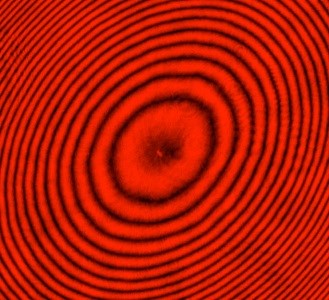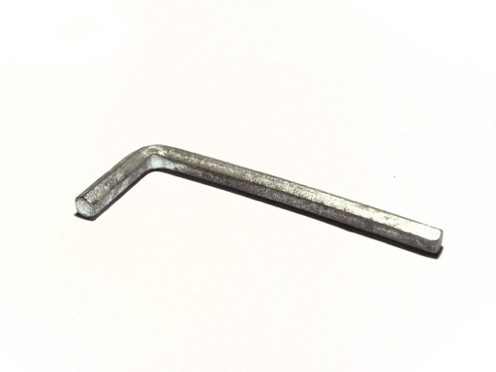
Glossary
1/4-20
The screw size that is usually used to mount optics to a table. 1/4 is the diameter (in inches) of the screw hole, and there are 20 threads per inch.

Brewster’s angle
A specific angle of incidence that results in the reflection coefficient for one polarization (that which is parallel to the plane of incidence) to be zero.
Clipping
When a beam passes through an aperture, but the edges of the beam are blocked. A rule of thumb is that any aperture a beam passes through should be at least 3 times larger than the beam size to avoid significant losses and changes in beam profile from clipping.
Coherence length
The maximum path length difference that two beams can have and still maintain enough of a phase relationship that they produce visible interference.
Degree of polarization
A value that expresses the fraction of total optical power that can be described by a well defined polarization state.
Eigenmode
A beam of a particular size and spatial profile that will re-image itself on each round trip in a cavity.
Fabry-Perot cavity
A multiple beam interferometer usually consisting of two partially transmissive mirrors that trap light in between them. They are useful as a way to cause a beam to pass many times through a small volume (for instance to increase the effective path length when interacting with gas in a glass cell) and are also commonly used to discriminate against closely spaced frequencies, since their transmission is strongly dependent on frequency.
Fingerprints
This is how most laser optics get destroyed
Free spectral range
The range over which the output spectrum of a Fabry-Perot cavity varies before the spectrum repeats with modes of the next higher (or lower) order.
Fringes
A pattern of stripes or rings caused by interference of two (or more) beams. 
Full width at half maximum
A measure of the width of a pulse. It is (as its name suggests) the width of the pulse at the level where the amplitude is 50% of the peak.
Gaussian beams
A beam with a Gaussian intensity profile, which is an eigenmode of propagation, in that its profile remains unchanged (except for a change in phase and scale) as it propagates. Gaussian beams are a natural eigenmode of cavities with spherical mirrors (such as lasers) and therefore most laser beams are Gaussian.
Half-wave plate
An optical component that introduces a phase shift of π (equivalent to a spatial delay of λ/2) for one linear polarization state relative to the orthogonal polarization state.
Hex key
A hexagonal shaped rod that is placed inside the cap head of a screw to turn it. Also called allen-keys. 
HVAC
Heating, Ventilation and Cooling system. These units are present in all buildings and produce lots of vibrations that can produce noise in optical experiments, particularly interferometric measurements. Often times it is necessary to take measurements at times when the HVAC system is idle to avoid this source of noise.
Input impedance
The impedance (measured in ohms) that a signal going into a device sees. It is often desirable for a device to have as large an input impedance as possible to minimize the current draw from whatever it is connected to, however, devices intended to operate at radio frequencies will often have a 50 Ω input impedance to match the characteristic impedance of the cables used for interconnecting devices - this helps prevent reflections at the input that can produce unwanted standing waves on the cables.
Interference condition
The relative phase shift between beams that is responsible for determining the phase of the interference pattern.
Interlock
A mechanical switch in series with a laser power supply that will turn off the laser when it is opened. Interlocks are often attached to the housing of the laser so that if it is removed the laser won’t operate. Many power supplies have terminals for connecting an external interlock that might be mounted on a door to the lab, so that the laser turns off if the door is opened, protecting anybody entering the room from the potential hazards of laser radiation.
Intrinsic capacitance
This is the capacitance that is inherent in an object - for instance photodiodes are made of layered semiconductors, with electrodes on the outer layers. This geometry is analogous to a parallel plate capacitor. Thus the intrinsic capacitance of the photodiode scales linearly with its area.
Low pass filter
A circuit element that, due to its finite response time, is unable to respond to rapid changes in the input. Thus the low frequency components of the input signal are passed, but the high-frequency components are blocked.
Microscope lens
In laser optics a microscope lens is often used as a short focal length, high numeric aperture lens because it comes pre-mounted on a standard sized barrel, and is often is manufactured as a compound lens that has been optimized for low aberration when focusing a collimated beam.
Mode
An optical mode is a particular size and shape of the beam.
Optical density
A measure of how much absorption a material has. The higher the number the less transmission. It is defined by 10 log10(It/Io), so an optical density of 3 will only transmit 0.001 of the incident power, and an optical density of 6 will only transmit 0.000001 of the incident power.
Photodiodes
An opto-electronic device that converts incident photons into free charge carriers. The term can also refer to a photodiode packaged with other electronics as a photodetector that produces an output current or voltage proportional to the input optical power.
Piezo stacks
A geometric configuration of many thin layers of a piezo-electric material with electrodes between each. This geometry allows an applied voltage to produce much higher electric fields in the material so that the total expansion is increased, but the tradeoff is that they cost much more and have higher capacitance which makes them harder to drive at high frequencies.
Piezo-electric
An element that expands in the presence of an applied voltage. They are used to electronically actuate mirrors. These devices typically require high-voltage, 1 kV or so to expand by a few microns.
PZTs
Common abbreviation for lead zirconate titanate, a widely used piezo electric material.
Quarter-wave plate
An optical component that introduces a phase shift of π/2 (equivalent to a spatial delay of λ/4) for one linear polarization state relative to the orthogonal polarization state.
Resolving power
The ability of a device to measure variations in a quantity expressed as the average value of the quantity divided by the smallest detectable change. It is a unit-less number that tells us, for a Fabry-Perot cavity, how many discrete frequencies of the input light can be resolved.
Response time
The time it takes a device to respond to a change in the signal. If there is an instantaneous change in the input, the response time is usually defined as the time for the output to change by 1/e of the amount it will change in the steady state.
Speckle
A chaotic pattern of bright and dark areas observed on laser beams. Speckle arises from phase variation in the paths that light can take to reach a given point. Dirty or rough optics are one source of speckle.
Thermal photometers
A tool for measuring optical power that functions by measuring the temperature rise of an absorber that is due to the absorbed light.
Threshold current
The minimum current necessary to get a laser to operate.
Trigger
A signal that tells an oscilloscope to begin drawing the next video frame. If the frame rate is synchronized to the repetition frequency of the signal being plotted, a stationary representation of the signal will be visible. Thus it is often useful to set the trigger to occur on some feature of the signal itself. Alternatively the trigger can be set from a second signal that is synchronized with that being displayed - for example, function generators will usually output a square wave “sync” signal for triggering that is synchronized to the main output. Another common signal to trigger from is the “AC line” which is useful when the signal being observed has a frequency that is a harmonic of the electrical wall-plug frequency (50HZ or 60Hz).
Visualizer card
A card that emits a visible glow in the presents of near invisible light (different cards can be used for ultraviolet, near infrared, or mid infrared regions of the spectrum).
Waist
The position along the propagation axis of a beam where its transverse profile is the smallest.